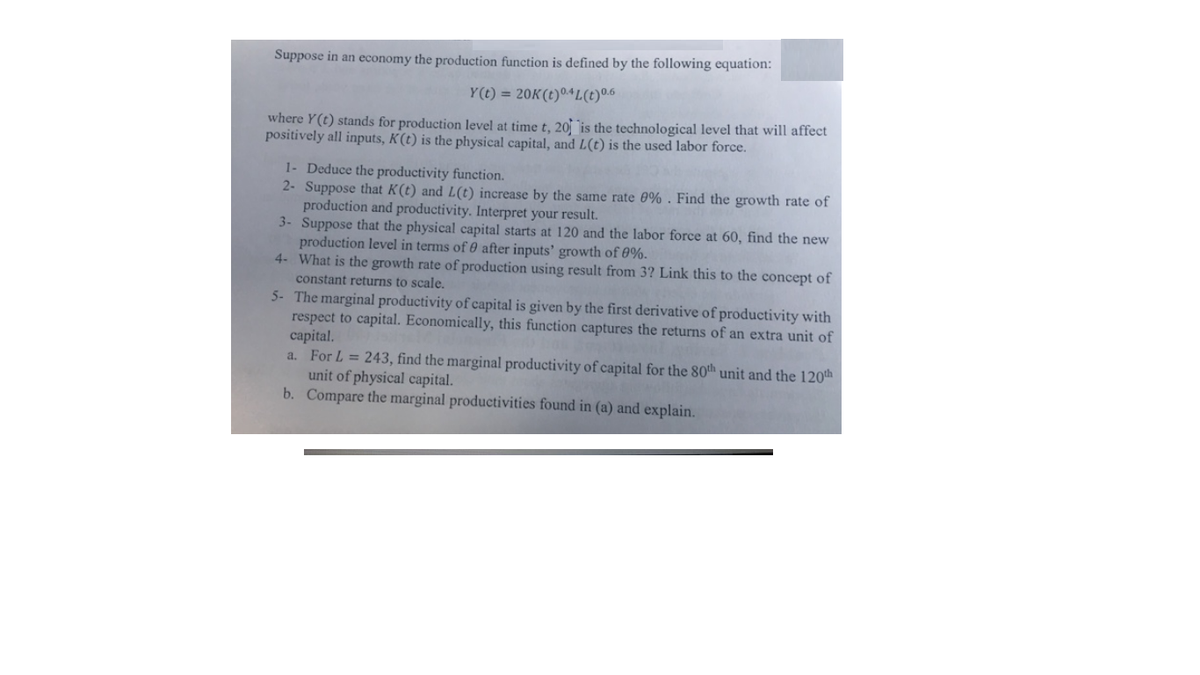Suppose in an economy the production function is defined by the following equation: Y(t) = 20K(t)04L(t)0.6 where Y(t) stands for production level at time t, 20 `is the technological level that will affect positively all inputs, K(t) is the physical capital, and L(t) is the used labor force. 1- Deduce the productivity function. 2- Suppose that K(t) and L(t) increase by the same rate 0% . Find the growth rate of production and productivity. Interpret your result. 3- Suppose that the physical capital starts at 120 and the labor force at 60, find the new production level in terms of 0 after inputs' growth of 0%. 4- What is the growth rate of production using result from 3? Link this to the concept of constant returns to scale. 5- The marginal productivity of capital is given by the first derivative of productivity with respect to capital. Economically, this function captures the returns of an extra unit of capital. a. For L = 243, find the marginal productivity of capital for the 80th unit and the 120th unit of physical capital. b. Compare the marginal productivities found in (a) and explain.
Suppose in an economy the production function is defined by the following equation: Y(t) = 20K(t)04L(t)0.6 where Y(t) stands for production level at time t, 20 `is the technological level that will affect positively all inputs, K(t) is the physical capital, and L(t) is the used labor force. 1- Deduce the productivity function. 2- Suppose that K(t) and L(t) increase by the same rate 0% . Find the growth rate of production and productivity. Interpret your result. 3- Suppose that the physical capital starts at 120 and the labor force at 60, find the new production level in terms of 0 after inputs' growth of 0%. 4- What is the growth rate of production using result from 3? Link this to the concept of constant returns to scale. 5- The marginal productivity of capital is given by the first derivative of productivity with respect to capital. Economically, this function captures the returns of an extra unit of capital. a. For L = 243, find the marginal productivity of capital for the 80th unit and the 120th unit of physical capital. b. Compare the marginal productivities found in (a) and explain.
Chapter9: Production Functions
Section: Chapter Questions
Problem 9.2P
Related questions
Question
Find the attached file.

Transcribed Image Text:Suppose in an economy the production function is defined by the following equation:
Y(t) = 20K(t)04L(t)0.6
where Y(t) stands for production level at time t, 20 `is the technological level that will affect
positively all inputs, K(t) is the physical capital, and L(t) is the used labor force.
1- Deduce the productivity function.
2- Suppose that K(t) and L(t) increase by the same rate 0% . Find the growth rate of
production and productivity. Interpret your result.
3- Suppose that the physical capital starts at 120 and the labor force at 60, find the new
production level in terms of 0 after inputs' growth of 0%.
4- What is the growth rate of production using result from 3? Link this to the concept of
constant returns to scale.
5- The marginal productivity of capital is given by the first derivative of productivity with
respect to capital. Economically, this function captures the returns of an extra unit of
capital.
a. For L = 243, find the marginal productivity of capital for the 80th unit and the 120th
unit of physical capital.
b. Compare the marginal productivities found in (a) and explain.
Expert Solution
This question has been solved!
Explore an expertly crafted, step-by-step solution for a thorough understanding of key concepts.
Step by step
Solved in 3 steps

Knowledge Booster
Learn more about
Need a deep-dive on the concept behind this application? Look no further. Learn more about this topic, economics and related others by exploring similar questions and additional content below.Recommended textbooks for you


Principles of Economics (MindTap Course List)
Economics
ISBN:
9781305585126
Author:
N. Gregory Mankiw
Publisher:
Cengage Learning

Principles of Microeconomics (MindTap Course List)
Economics
ISBN:
9781305971493
Author:
N. Gregory Mankiw
Publisher:
Cengage Learning


Principles of Economics (MindTap Course List)
Economics
ISBN:
9781305585126
Author:
N. Gregory Mankiw
Publisher:
Cengage Learning

Principles of Microeconomics (MindTap Course List)
Economics
ISBN:
9781305971493
Author:
N. Gregory Mankiw
Publisher:
Cengage Learning